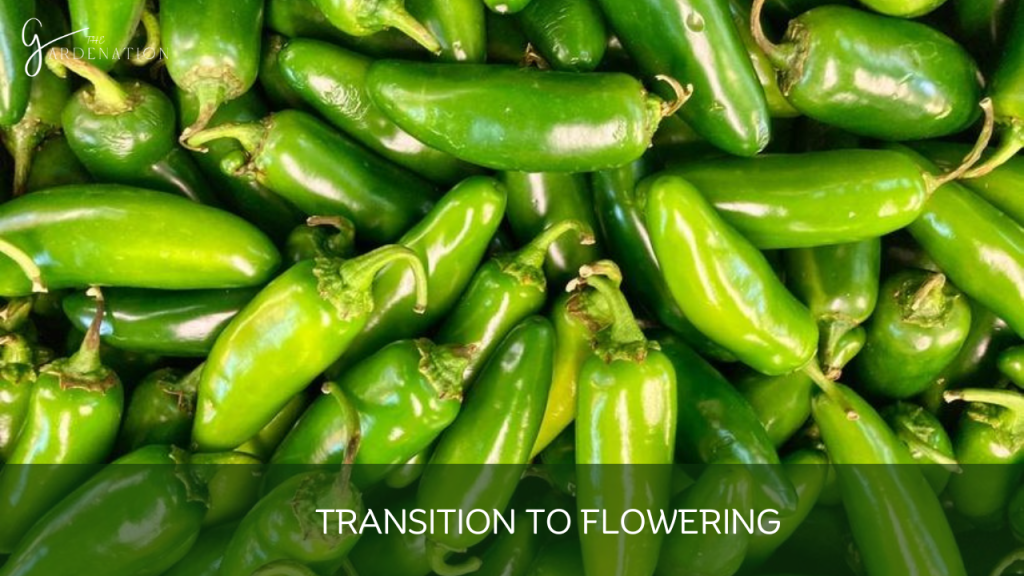Jalapeño Growth Stages (thegardenation)
Jalapeño peppers (Capsicum annuum) bring a delightful kick of heat and vibrant flavor to salsas, Tex-Mex dishes, and more. Their popularity in cuisines across the globe sparks curiosity into the secrets behind growing these Mexican natives.
From germinating those tiny seeds to harvesting armloads of glossy green or scarlet red peppers, jalapeños progress through several captivating jalapeno growth stages during their life cycle.
I have explored the optimal conditions for flourishing jalapeño plants and demystify their timeline from emergence to maturity. I have examined each stage of development from seedlings working to establish roots to mature plants loaded with pungent fruit.
I discovered best practices for nourishing vigorous vegetation, troubleshooting pollination issues, and determining prime harvest timing. Arm yourself with knowledge to unravel the mysteries of jalapeño cultivation.
Conditions for Growing Jalapeño

To set the stage for success, jalapeño plants require specific environmental factors and care tailored to their preferences as heat-loving natives of central Mexico.
Origin and Ideal Temperature
Jalapeños belong to the diverse Capsicum annuum species of hot peppers encompassing other favorites like serranos, cayenne, and Anaheim. This tropical perennial evolved to thrive in the hot, sunny conditions of southern Mexico. When grown as annuals, they flourish with daytime temperatures of 65-85°F and nights staying above 60°F. Cooler weather below 55°F can stress plants and delay fruiting. Their heat-tolerant nature allows jalapeños to continue producing through summer.
Sunlight, Wind, and Soil Requirements
Robust jalapeños with abundant fruit need at least 6 hours of direct sun daily. With insufficient light, they concentrate growth in foliage rather than fruit production. I use sheltered locations that avoid relentless wind to allow thorough pollination by bees rather than blustery conditions blowing pollen away prematurely.
In terms of soil, I provide jalapeños with well-draining, nutrient-rich conditions with a pH around 6.0-6.8. They tolerate sandier soils better than heavy clay and appreciate generous additions of compost or aged manure. For container gardening, I use potting mixes formulated for vegetables with adequate permeability.
Watering and Container Gardening
Jalapeño plants demand consistent moisture during fruiting, especially in containers where roots have limited access to water and nutrients.
I allow soil to dry slightly between waterings without severely stressing plants. Inconsistent irrigation that fluctuates between overly wet and dry inhibits nutrient absorption and causes misshapen fruit.
Container gardening enables growing jalapeños in small spaces, but I use at least 5-gallon pots and monitor soil moisture frequently. I improve drainage by adding gravel, sand, or wood chips to container bottoms.
Growth Stages of Jalapeño Plants

Now that I’ve covered fundamental growing requirements, let me tell you the intriguing transformation jalapeños undergo as they journey from seed to fruitful plant. This section provides an in-depth look at each phase of development.
Seed Germination

Jalapeño seeds germinate slowly compared to other peppers, taking 7-21 days while ideal soil temperatures measure 80-90°F.
Since cooler spring soil lags behind these conditions, starting seeds indoors gives plants a head start to mature before fall frosts. I sow seeds 1⁄4 inch deep in the seed starting mix.
As seedlings grow, I gradually expose them to sunnier and cooler conditions over 7-14 days (known as hardening off) before transplanting outdoors after the last expected fr
Seedlings and Early Growth

Around 5-12 days after sowing seeds, the first seedling structures emerge from the soil. The rounded cotyledons or seed leaves absorb nutrients from the seed to generate initial growth before the first true leaves form.
These slightly pointed true leaves follow next from the central stem, with 5-6 pairs signaling the seedling is mature enough for transplanting into the garden. I gently separate seedlings with labeling sticks or plant markers to track varieties.
Vegetative Growth

Once established in the garden, jalapeño seedlings focus energy on vigorous leaf and stem development for the next 4-8 weeks before flowering commences. This important vegetative phase builds extensive root systems and substantial plant infrastructure to support future fruit.
I apply a balanced liquid fertilizer with slightly higher nitrogen every couple weeks to fuel healthy foliage. I prune off any early flowers or fruit to direct growth into vegetation initially. Container gardening requires closer monitoring for sufficient nutrients and water. I use granular time-release fertilizer at planting to supply steady nourishment.
I check container plants daily for moisture needs compared to garden beds with better water retention. High temperatures on container surfaces may inhibit flowering, so I monitor for pollination issues.
Flowering, Pollination, and Fruit Development

As jalapeños transition from the juvenile stage into reproductive growth, the white flowers that later form fruit begin blossoming under optimal conditions.
If you want to know more about us you can visit: Watermelon Plant Stages
Transition to Flowering

After 50-70 days of vegetative expansion, established jalapeño plants start forming flower buds at every leaf node as they enter the flowering phase. This signals the cue to switch from high nitrogen fertilizers to formulations higher in phosphorus and potassium which support flowering and fruit production. The lush green foliage contrasts beautifully with a mix of white buds and flowers blooming simultaneously for 4-6 weeks.
Pollination and Fertilization

Jalapeño flowers follow a daily bloom pattern, opening in the morning then fading by afternoon. As flowers open, the pollen-bearing anthers shed abundant grains of powdery yellow pollen, ready for transfer to the female stigma of the same or another flower. Like many peppers, jalapeños are self-fertile so pollinators are not essential but can facilitate the process.
Bees, butterflies, and other insects that brush against dangling anthers cross-pollinate flowers as they collect nectar. If growing multiple varieties, netting prevents cross-pollination between plants.
Fruit Development and Ripening

Successfully pollinated flowers transition into small green fruit behind each wilted corolla. Tiny pepper buds enlarge rapidly over the next 55-70 days, transforming from green to red as they fully ripen.
During peak fruiting, I selectively pinch off new buds to redirect energy towards ripening existing fruit rather than forming new ones. Mature jalapeño peppers reach 3-5 inches long, turning bright red when fully ripe.
Jalapeño Plant Growth Timeline – A Visual Journey

While the nuances of distinct growth phases fascinate attentive gardeners, visuals help cement this sequence of development. This section takes an up-close look at the timeline of key events through photos, time-lapse videos, and illustrations of jalapeño plants advancing through each stage.
Harvesting Techniques
As the long-awaited harvest approaches, optimal timing and efficient methods ensure high quality yields to savor. I’ll also tackle common queries about troubleshooting odd fruit shapes, bolting plants, and other jalapeño plant problems.
When to Harvest
Patience through the long journey from seed to fruit pays off with a bountiful harvest. Jalapeños require around 60-80 days from transplanting to begin producing ripe peppers.
Depending on personal preference and intended use, jalapeños can be picked green or allowed to ripen fully to red. Green jalapeños offer the most heat and bright flavor, while red ones tend to rank slightly lower on the Scoville scale with a sweeter taste.
I check fruit regularly as they reach mature size, waiting for jalapeños to develop a shiny, smooth exterior skin without indentations or cracks.
Gently testing firmness indicates ripeness when they yield slightly to pressure but remain sturdy. I use sharp pruners to cut stems just above the fruit, leaving about 1⁄2 inch of the stem attached.
Lifespan of Jalapeño Plants and Fruit Production

Given ideal warm conditions with sufficient water and nutrients, jalapeño plants continue producing peppers for many seasons in their native climates. Grown as annuals, fruit declines as daylight hours become shorter in late summer to fall.
However, established plants often persist through winter in protected areas and generate earlier yields the following season. Troubleshoot lack of fruit set by testing soil pH and nutrients and inspecting for evidence of early bud drop or blossom end rot.
I ensure consistent soil moisture and avoid applying excess nitrogen late in growth. In garden conditions with full sun, expect around 20-30 peppers per healthy jalapeño plant, depending on container size and other variables.
Frequently Asked Questions
1. How much sun do jalapeno pepper plants need?
Jalapeno peppers need full sun exposure for at least 6-8 hours per day. Partial shade is okay, but less sunlight can result in slower growth and lower yields. I make sure to choose a location that receives direct sunlight for most of the day.
2. How far apart should I space jalapeno pepper plants?
I space jalapeno pepper plants about 18-24 inches apart in all directions. This gives them adequate room to grow without overcrowding. Overcrowded plants compete for sunlight and nutrients, leading to reduced growth.
3. How often should I water jalapeno pepper plants?
I water jalapeno plants about 1-2 inches per week. I check the soil moisture before watering and only water when the top 1 inch becomes dry. I also make adjustments based on weather and plant size. Consistent moisture is important, but I take care not to overwater as that can cause root rot.
4. When should I start harvesting jalapeno peppers?
I start harvesting jalapenos once the peppers reach mature green size, about 2-3 inches long. You can pick them earlier for a milder flavor or allow some to ripen to red on the plant for more heat. I use scissors for clean cuts and try to harvest every few days to encourage more production.
5. What causes small or misshapen jalapeno peppers?
Issues like irregular watering, extreme temperatures, lack of nutrients, and insufficient sunlight can lead to small, stunted, or oddly-shaped jalapeno fruit. I make sure plants receive even moisture, fertilizer if needed, protection from heat/cold, and at least 6 hours of direct sun.
Conclusion
My voyage through the life cycle of Capsicum annuum from germination to harvest reveals fascinating insights into maximizing yields of these captivating peppers. From understanding critical growing conditions to recognizing key timeline markers, you now hold the keys to unlocking the secrets of homegrown jalapeños.
Consider using this guide as you cultivate their spirited flavor to spice up salsas, Tex-Mex dishes, and more. No longer will you view jalapeños as mysterious—instead, appreciate them as the culmination of natural development intricately timed to delight our palates.


2 Comments